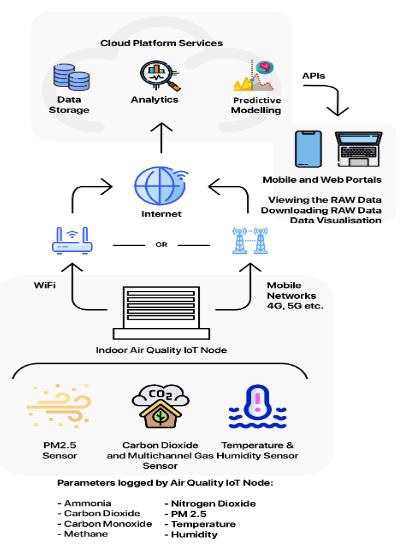On average, humans spend around 90 % of their time indoors, which highlights the importance of indoor air quality. Indoor air quality typically encompasses the ambient conditions inside buildings and public facilities that may affect both the mental and respiratory health of an individual. Until the COVID-19 outbreak, indoor air quality monitoring was not a focus area for public facilities such as shopping complexes, hospitals, banks, restaurants, educational institutes, and so forth. However, the rapid spread of this virus and its consequent detrimental impacts have brought indoor air quality into the spotlight. In contrast to outdoor air, indoor air is recycled constantly causing it to trap and build up pollutants, which may facilitate the transmission of virus.
There are several monitoring solutions which are available commercially, a typical system monitors the air quality using gas and particle sensors. These sensor readings are compared against well-known thresholds, subsequently generating alarms when thresholds are violated. However, these systems do not predict the quality of air for future instances, which holds paramount importance for taking timely preemptive actions, especially for COVID-19 actual and potential patients as well as people suffering from acute pulmonary disorders and other health problems. In this context, Internet of Things (IoT) Lab, NUST-SEECS has developed the IoT-based solution for indoor air quality monitoring as shown in Figure 1. This node monitors temperature, humidity, PM2.5 dust particles, CO, NO2, and CH4, and CO2. This data is uploaded to cloud storage for further analysis. The node has an integrated display screen to show the sensed data as represented in the Figure 1.

For proof of concept and research purposes, the IoT node consisting of multiple sensors majorly for 8 pollutants including NH3, CO, NO2, CH4, CO2, PM 2.5 along with the ambient temperature & air humidity was deployed inside a research lab to acquire indoor air data. The developed node has the capability of reporting the air conditions in real-time to a web portal through Wi-Fi technology and generates alerts after detecting anomalies in the air quality. In order to classify the indoor air quality, several machine learning algorithms have been applied to the recorded data, where the Neural Network (NN) model outperformed all others with an accuracy of 99.1%. Figure-2 shows the architecture of the developed system. For predicting the concentration of each air pollutant and thereafter predicting the overall quality of an indoor environment, Long and Short-Term Memory (LSTM) model is applied. This model has shown promising results for predicting the air pollutants’ concentration as well as the overall air quality with an accuracy of 99.37%, precision of 99%, recall of 98%, and F1-score of 99%.

The web portal developed is the fundamental software infrastructure running on the local server that managed all the incoming data from the hardware nodes. The back-end system continuously listens for the data and archive it into a structured database. The main purpose of web portal development is the data management and visualization where it depicts the incoming data from the network with the help of various info graphics. Additionally, it is useful in accessing the raw values in order to get a detailed view of the all the parameters being reported by the system. The color-coded values displayed on the web portal are indicative of the varying levels of air quality, ranging from safe to unsafe zones. Figure 3 shows the webpage database, where as Figure 4 shows the air quality profile through multiple graphs.
The developed solution offers several advantages including remote monitoring, ease of scalability, real-time status of ambient conditions, and portable hardware, and so forth. In [1], we presented a standard and low-cost solution based on Internet of Things (IoT) technology, which was a cost-effective alternative to traditional air quality monitoring systems. Through the proposed solution, air quality monitoring was demonstrated by collecting data using temperature, humidity, carbon monoxide and nitrogen dioxide sensors and subsequently performed data analysis to infer the relationship of pollutant gases with weather parameters influencing the air quality. In [2], a better and more sustainable version was developed with the capability of real time reporting of air conditions to a web portal and mobile app through GSM/Wi-Fi technology and generates alerts after detecting anomalies in the air quality.

Through this research we support the concept of “Going Green” to sustain healthy, and cleaner environment for current and future generations.

References
[1] Hammad Amir, Rafia Mumtaz, Hirra Anwar, Stefan Poslad, “A Very Low Cost, Open, Wireless, Internet of Things (IoT) Air Quality Monitoring Platform”, Proceedings of the 15th International IEEE HONET-ICT, 2018, Pakistan. DOI: 10.1109/HONET.2018.8551340
[2] Rafia Mumtaz, Syed Mohammad Hassan Zaidi, Muhammad Zeeshan Shakir,Uferah Shafi, Muhammad Moeez Malik, Ayesha Haque, Sadaf Mumtaz, Syed Ali Raza Zaidi , “Internet of Things (IoT) based Indoor Air Quality Sensing and Predictive Analytic: A COVID-19 Perspective”, Electronics, Vol. 10 , PP. 1-26, Jan, 2021. IF: 2.412. DOI: 10.3390/electronics10020184
The author is the Director at Internet of Things (IoT) Lab and is also an Tenured Associate Professor at NUST School of Electrical Engineering and Computer Science. She can be reached at rafia.mumtaz@seecs.edu.pk.
Researcher’s Profile: https://bit.ly/36i7Oti





